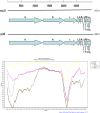Genomic characterization and infectivity of a novel SARS-like coronavirus in Chinese bats
- PMID: 30209269
- PMCID: PMC6135831
- DOI: 10.1038/s41426-018-0155-5
Genomic characterization and infectivity of a novel SARS-like coronavirus in Chinese bats
Erratum in
-
Correction.Emerg Microbes Infect. 2020 Dec;9(1):2727. doi: 10.1080/22221751.2020.1857048. Emerg Microbes Infect. 2020. PMID: 33356975 Free PMC article. No abstract available.
Abstract
SARS coronavirus (SARS-CoV), the causative agent of the large SARS outbreak in 2003, originated in bats. Many SARS-like coronaviruses (SL-CoVs) have been detected in bats, particularly those that reside in China, Europe, and Africa. To further understand the evolutionary relationship between SARS-CoV and its reservoirs, 334 bats were collected from Zhoushan city, Zhejiang province, China, between 2015 and 2017. PCR amplification of the conserved coronaviral protein RdRp detected coronaviruses in 26.65% of bats belonging to this region, and this number was influenced by seasonal changes. Full genomic analyses of the two new SL-CoVs from Zhoushan (ZXC21 and ZC45) showed that their genomes were 29,732 nucleotides (nt) and 29,802 nt in length, respectively, with 13 open reading frames (ORFs). These results revealed 81% shared nucleotide identity with human/civet SARS CoVs, which was more distant than that observed previously for bat SL-CoVs in China. Importantly, using pathogenic tests, we found that the virus can reproduce and cause disease in suckling rats, and further studies showed that the virus-like particles can be observed in the brains of suckling rats by electron microscopy. Thus, this study increased our understanding of the genetic diversity of the SL-CoVs carried by bats and also provided a new perspective to study the possibility of cross-species transmission of SL-CoVs using suckling rats as an animal model.
Conflict of interest statement
All authors declare that they have no conflicts of interest.
Figures






References
MeSH terms
Substances
Grants and funding
LinkOut - more resources
Full Text Sources
Other Literature Sources
Research Materials
Miscellaneous
